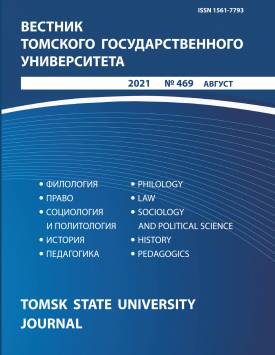Market Trade as a Stage of the Far Eastern Citizens' Life Trajectory (The 1990s)
On the basis of biographical sources, the article shows the experience of ordinary trade participants' work at “open markets” in the long historical retrospective (about 10 years). Differences in the perception of the new lifestyle and social status at the time of the events (by letters) and post factum (in memories) are analyzed. The article used the previously unknown complex of documents from the author's personal archive - the correspondence of a Far Eastern family for 1991-1999 (81 letters), as well as memoirs about the 1990s (74 essays) recorded in 2013-2014 and stored in the Archive of the Department of Socio-Political Research of the Institute of History, Archaeology and Ethnography of the Far Eastern Branch of the Russian Academy of Sciences. The focus is on the ways of rationalizing the people's choice to trade, and on the identification of the stages of involvement in trading practices, the range of changes in forms of activity within the market format, and results in solving everyday problems by trading. There are several stages in the trajectory of “entering” the market: “speculation” with scarce goods obtained with ration stamps and clothes coupons (moreover, this illegal Soviet practice is becoming a wide-spread phenomenon and a norm, especially among pensioners); market trade as secondary employment; market trading as the main activity; job search by specialty and “exit” from trade. Each “entry” stage could take about a year; when trade was the main activity (about five years), people could move from one market sector to another in search of more income and more comfortable working conditions. Going beyond the market format was hampered by the filter bubble and the general lack of good jobs in the 1990s. The comparison of sources that emerged directly in the 1990s and those recorded later shows that the actual perception of market trading and the historical memory of it are different. In a crisis, the fact of survival (and necessity entrepreneurs) was perceived as an unconditional benefit. With the crisis behind, the survival situation (and trade) is remembered as a humiliating and unnecessary experience outside the normal biographical trajectory. On the whole, in the conditions of the transformational crisis, the Far East citizens showed the ability for pre-adaptation - readiness for new forms of activity without preparation in the previous experience of the Soviet person, and “open markets” acted as the initial centers of social homeostasis - relatively isolated communities trying to survive in an aggressive and dynamically changing economic space.
Keywords
Russian Far East, market trade, open markets, “ohelnoki”, everyday lifeAuthors
| Name | Organization | |
| Kovalevskaya Yuliya N. | Institute of History, Archaeology and Ethnography of the Peoples of the Far East, FEB RAS | tupa67@mail.ru |
References

Market Trade as a Stage of the Far Eastern Citizens' Life Trajectory (The 1990s) | Vestnik Tomskogo gosudarstvennogo universiteta – Tomsk State University Journal. 2021. № 469. DOI: 10.17223/15617793/469/19
